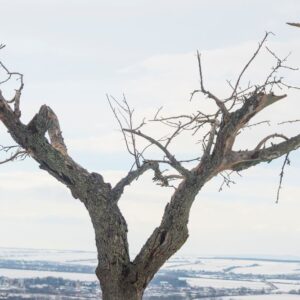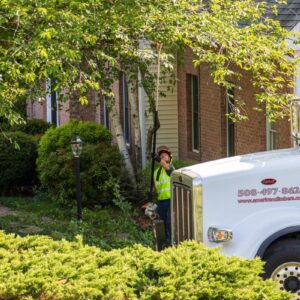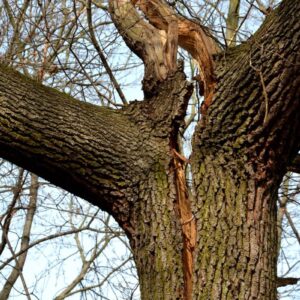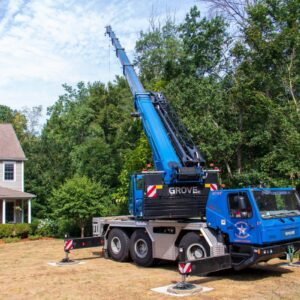We’re often asked about the best time to prune trees or shrubs. And while it’s usually safe to assume that your plants can be pruned in winter, the more accurate answer is “it depends.” The right time to prune trees and shrubs varies depending on the species, age, and condition of the plant.
What to Prune in Winter
Believe it or not, winter is an ideal time to prune nearly all trees and woody shrubs. In fact, some tree services, such as pruning fruit trees to maximize fruit production, should only be done while trees are dormant during winter. Yes, it may be cold out but, as the Norwegians say, there’s “no bad weather, only bad clothes,” so bundle up!
Trees and shrubs, like hibernating animals, respond to winter’s colder temperatures and short hours of sunlight by slowing their activity to a crawl. Also like animals, trees have spent the summer storing up energy reserves. When freezing temperatures and short days arrive, both dormant trees and hibernating animals rely on those energy reserves to get them through the cold months of winter until spring re-awakens them.
Benefits of Winter Pruning
Because dormant shrubs and trees are “asleep,” winter pruning has some important benefits, including these:
- It won’t disturb their growth patterns or stimulate new leaf growth.
- Without leaves, it’s easier to see the structure of the tree so the proper pruning cuts can more easily be made.
- The usual insect pests and diseases are not active during winter, so pruning cuts won’t provide entryways for them to attack your trees.
- The pruning cuts you make during dormancy will start to be sealed off as soon as the tree awakens in spring, so the wound has a head start on keeping out destructive pests and diseases.
- Any hazards can be quickly seen and removed before they can compromise the safety of your property and loved ones (especially when we get heavy snow or ice loads from winter storms).
While tree care professionals take advantage of winter to prune, reputable tree service companies don’t work when winter conditions are hazardous to people or trees. When temperatures drop dangerously low, when heavy snow collects in trees, or when ice loads develop in trees and atop roads, our pruning experts won’t work. We’ll wait till conditions are safer for you, your property, and our crews.
What to Prune in Spring
There are some shrubs and trees that you shouldn’t prune in winter, and these are early spring-flowering species. After they finish flowering, these early bloomers set buds for the following year’s flowering. This means they flower on what’s called “old” wood (growth that developed during the previous growing season).
Early spring-blooming plants finish their flowering and fruiting cycle in the middle of the growing season and then set to work making next spring’s buds. Because of this, you’ll want to prune them just after they finish flowering. The goal is to prune before buds for next year are made, so that you can both control the shape and size of the plant and maximize its future flowering. If you prune off branches during the winter or later in the growing season, you’ll be pruning off all those future flower buds.
Examples of spring-flowering species that you prune during the growing season include:
- Dogwood (Cornus)
- Forsythia
- Witch hazel (Hamamalis)
- Rhododendron
- Spring-flowering trees like maple and flowering cherry (Malus, Prunus)
- Lilac (Syringa)
Remember how welcome the early blooms of forsythia and witch hazel are when all around so many trees and shrubs are bare, and the weather is still too cold to enjoy spending time in your garden? To ensure that you get those early flowers, prune them just after they’ve finished their show.
What to Prune in Summer
While summer isn’t the time to do major pruning, it is the right time to do certain types of pruning. If you’re a novice pruner, you might want to wait until you’re very familiar with the plants in your garden, and you’ve watched the results of your pruning over a few annual cycles. You’ll be better equipped to know how much to prune.
There are many reasons to prune in summer, such as:
- Improving the tree’s overall shape when it’s fully leafed out so you can better see the impact of your pruning efforts
- Controlling summer growth on trees or shrubs that have grown too large or are getting in the way
- Opening up tree crowns to increase sunlight and air circulation throughout the interior
- Raising the tree canopy to open up a view
- Removing dead, damaged, or diseased leaves and branches from among healthy foliage
Until trees have fully leafed out, some underlying issues are not obvious or cannot be seen, while other problems occur as the tree continues to grow. And, of course, dead, damaged, or diseased branches and trees should always be removed when you first notice them, regardless of the time of year.
PRO TIP: One of the dangers of pruning during the growing season is the increased risk of pathogens or pests entering through open pruning wounds. If your trees are actively infested with insects, or if Dutch elm disease or oak wilt is present, talk to a tree care professional before doing any pruning.
What to Prune in Fall
There’s only one season left to discuss, and that’s fall. Fall is the one season that’s not good for pruning.
Except for removing damaged or diseased branches, don’t prune trees and woody shrubs in fall.
Fall pruning, like all pruning, stimulates growth, but new fall growth will shortly be killed by the dropping temperatures that usher in winter. With winter approaching, this short-lived fall growth will end up being useless to the tree or shrub, and precious stored energy reserves will have been depleted to make this doomed foliage.
A Final Word
Now that you have an overview of when and how to prune, remember this other important pruning rule: all pruning should be minimal, removing only what is required. One of the benefits of regular pruning over the course of a shrub’s or tree’s life is that the fewest number of branches and foliage are removed each time, and what is removed is done with an eye to the overall shape and vigor of the plant.
For pruning, more is not better. And while some people who hire tree care professionals may think that a lot of pruning and a lot of debris means they got their money’s worth, knowledgeable homeowners know they can trust reputable tree service companies to do exactly what’s needed – and nothing more.
Need a Hand?
If you’re looking for a trustworthy and experienced tree care company, look no further than American Climbers! Our lives are focused on ensuring your trees and shrubs are vigorous, healthy, and pruned to enhance their natural beauty over their lifetime. We’ll be happy to evaluate your trees and shrubs, and we’ll explain exactly what we think your plants need, and why. So if the thought of being outside in winter’s cold or wielding a pruning saw is less than appealing, give us a call and we’ll help you, and your trees, out.
Blog Topics
Recent Posts
What's Happening? Stay Informed!
Stay on top of local events, pest and disease updates, tree and landscape tips, and more. Delivered straight to your inbox each month.







